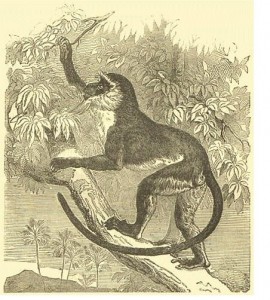SUNDAY, 27 MARCH 2011
 The primate order is a large and complex group of over 260 species, ranging from the tiny mouse lemur to the mountain gorilla, which arose from a common ancestor existing approximately 90 million years ago. Although sequencing of the entire genome of 12 primate species is now almost complete, the taxonomy of the primates as a whole has remained controversial. To address this problem, researchers sampled 186 primate species, encompassing 61 genera. For every species sampled, DNA from 54 gene regions was sequenced, and a tree of relationships was generated using computer-based algorithms [1]. The reliability or ‘robustness’ of such evolutionary trees can be estimated; in this case the tree was found to be exceptionally robust, allowing it to settle some long-standing disputes about how certain primate groups are related. In addition, the analysis provides an estimate of the rate of evolutionary change along different lineages. In agreement with previous studies, the human lineage was found to be one of the slowest-evolving primate groups.
The primate order is a large and complex group of over 260 species, ranging from the tiny mouse lemur to the mountain gorilla, which arose from a common ancestor existing approximately 90 million years ago. Although sequencing of the entire genome of 12 primate species is now almost complete, the taxonomy of the primates as a whole has remained controversial. To address this problem, researchers sampled 186 primate species, encompassing 61 genera. For every species sampled, DNA from 54 gene regions was sequenced, and a tree of relationships was generated using computer-based algorithms [1]. The reliability or ‘robustness’ of such evolutionary trees can be estimated; in this case the tree was found to be exceptionally robust, allowing it to settle some long-standing disputes about how certain primate groups are related. In addition, the analysis provides an estimate of the rate of evolutionary change along different lineages. In agreement with previous studies, the human lineage was found to be one of the slowest-evolving primate groups.The revised primate phylogeny will be an invaluable resource for a wide range of scientists, including evolutionary biologists and taxonomists, those interested in primate biology and conservation, and biomedical researchers using comparative genomic approaches to understand human genetic disorders [2].
Written by Emma Hatton-Ellis
